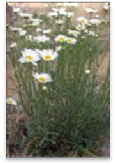Also Known as: white daisy, margurite, field daisy, poorland flower, moonpenny.
Oxeye daisy, Leucanthemum vulgare Lam., native to Eurasia, is an erect perennial that grows 1–3 feet tall. A single plant can produce up to 40 flowering stems, which are smooth and usually unbranched. Stalked basal leaves are spatula-shaped and narrowly lobed to blunt-toothed. Stem leaves become progressively smaller up the stem. Upper stem leaves are alternate, stalkless, and narrowly oblong with toothed margins. Flowering occurs during summer, with solitary flower heads growing at branch ends. The flowers are showy and daisy-like, with white petals surrounding yellow centers measuring about 1–2 inches in diameter. Each flower head can produce up to 200 seeds. Seeds are cylindrical, brown to black, with a ribbed coat and no pappus. The plant has a shallow, fibrous, rhizomatous root system. Oxeye daisy spreads mainly by seeds, but can also spread by the rhizomes. The entire plant has a disagreeable odor that is pungent when crushed. Oxeye daisy can carry several plant diseases. It thrives in a wide variety of soil types and is found in grasslands, overgrazed pastures, roadsides, and waste areas.
Photo by: Steve Dewey, Utah State University, Bugwood.org
Control Methods
Physical/Mechanical: Oxeye daisy can be deterred by maintaining competitive vegetation. Because of its shallow root system, small populations of oxeye daisy can be hand-pulled, taking care to remove all root segments. The plant is also easily controlled by regular cultivation. While mowing at the onset of flowering can prevent seed production, it can also stimulate shoot production and so must be repeated. Mechanical control measures should not be taken after seed set.
Chemical: Several broadleaf herbicides registered for use in pasture are effective against oxeye daisy, beginning when leaves are visible in the spring until flowering. Specifically, 2,4-D can be applied early, during the rosette stage, while picloram plus 2,4-D can be used during and after bolting. Picloram can injure desirable forbs, so use with caution. Herbicides containing clopyralid are also effective in controlling oxeye daisy. Application of nitrogen fertilizer can be nearly as effective as use of herbicides in reducing canopy cover, often because pastureland infested with oxeye daisy is nitrogen-deficient. Stimulated by fertilization, native and introduced perennial grasses can outcompete oxeye daisy.
More information can be found in the PNW Weed Management Handbook
USE PESTICIDES WITH CARE. Apply them only to plants, animals, or sites listed on the label. When mixing and applying pesticides, follow all label precautions to protect yourself and others around you. It is a violation of the law to disregard label directions. Store pesticides in their original containers and keep them out of the reach of children, pets, and livestock.
Biological: No insect or pathogen biological control agent is available for oxeye daisy control. While cattle generally avoid oxeye daisy, they can be used to reduce plant density through intensive managed grazing. Sheep and goats will readily eat the plant. Grazing can suppress plant populations, but does not by itself provide effective control, and overgrazing will only serve to increase oxeye daisy populations.
Questions: Contact Steve Van Vleet or phone (509) 397 – 6290
Photo credits included in PDF



